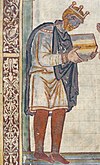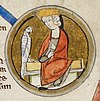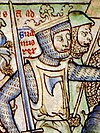
A | B | C | D | E | F | G | H | CH | I | J | K | L | M | N | O | P | Q | R | S | T | U | V | W | X | Y | Z | 0 | 1 | 2 | 3 | 4 | 5 | 6 | 7 | 8 | 9
| Monarchy of England | |
|---|---|
 | |
 | |
| Details | |
| First monarch | Alfred the Great |
| Last monarch | Anne |
| Formation | c. 886 (late 9th century) |
| Abolition | 1 May 1707 |
| Residence | Court of St James's |

This list of kings and reigning queens of the Kingdom of England begins with Alfred the Great, who initially ruled Wessex, one of the seven Anglo-Saxon kingdoms which later made up modern England. Alfred styled himself king of the Anglo-Saxons from about 886, and while he was not the first king to claim to rule all of the English, his rule represents the start of the first unbroken line of kings to rule the whole of England, the House of Wessex.[1]
Arguments are made for a few different kings thought to have controlled enough Anglo-Saxon kingdoms to be deemed the first king of England. For example, Offa of Mercia and Egbert of Wessex are sometimes described as kings of England by popular writers, but it is no longer the majority view of historians that their wide dominions are part of a process leading to a unified England. Historian Simon Keynes states, for example, that "Offa was driven by a lust for power, not a vision of English unity; and what he left was a reputation, not a legacy."[2] This refers to a period in the late 8th century when Offa achieved a dominance over many of the kingdoms of southern England, but this did not survive his death in 796.[3][4] Likewise, in 829 Egbert of Wessex conquered Mercia, but he soon lost control of it.
It was not until the late 9th century that one kingdom, Wessex, had become the dominant Anglo-Saxon kingdom. Its king, Alfred the Great, was overlord of western Mercia and used the title King of the Angles and Saxons, but he never ruled eastern and northern England, which was then known as the Danelaw, having earlier been conquered by the Danes from southern Scandinavia. His son Edward the Elder conquered the eastern Danelaw, but Edward's son Æthelstan became the first king to rule the whole of England when he conquered Northumbria in 927, and he is regarded by some modern historians as the first true king of England.[3][4] The title "King of the English" or Rex Anglorum in Latin, was first used to describe Æthelstan in one of his charters in 928. The standard title for monarchs from Æthelstan until John was "King of the English". In 1016 Cnut the Great, a Dane, was the first to call himself "King of England". In the Norman period "King of the English" remained standard, with occasional use of "King of England" or Rex Anglie. From John's reign onwards all other titles were eschewed in favour of "King" or "Queen of England".
The Principality of Wales was incorporated into the Kingdom of England under the Statute of Rhuddlan in 1284, and in 1301 King Edward I invested his eldest son, the future King Edward II, as Prince of Wales. Since that time, the eldest sons of all English monarchs, except for King Edward III,[a] have borne this title.
After the death of Queen Elizabeth I without issue in 1603, her cousin King James VI of Scotland inherited the English crown as James I of England, joining the crowns of England and Scotland in personal union. By royal proclamation, James styled himself "King of Great Britain", but no such kingdom was actually created until 1707, when England and Scotland united during the reign of Queen Anne to form the new Kingdom of Great Britain, with a single British parliament sitting at Westminster. This marked the end of the Kingdom of England as a sovereign state.
House of Wessex (886–1013)
| Name | Portrait | Birth | Marriage(s) | Death | Claim |
|---|---|---|---|---|---|
| Alfred[5] Alfred the Great (King of Wessex from 871) c. 886 – 26 October 899 (13 years) |

|
849 Son of Æthelwulf of Wessex and Osburh |
Ealhswith of Gainsborough 868 5 children |
26 October 899 Aged about 50 |
Son of Æthelwulf of Wessex Treaty of Wedmore |
| Edward the Elder[6] 26 October 899 – 17 July 924 (24 years, 266 days) |

|
c. 874 Son of Alfred and Ealhswith |
(1) Ecgwynn c. 893 2 children (2) Ælfflæd c. 900 8 children (3) Eadgifu of Kent c. 919 4 children |
17 July 924 Aged about 50 |
Son of Alfred |
Disputed claimant
There is some evidence that Ælfweard of Wessex may have been king in 924, between his father Edward the Elder and his half brother Æthelstan, although he was not crowned. A 12th-century list of kings gives him a reign length of four weeks, though one manuscript of the Anglo-Saxon Chronicle says he died only 16 days after his father.[7] However, the fact that he ruled is not accepted by all historians. Also, it is unclear whether—if Ælfweard was declared king—it was over the whole kingdom or of Wessex only. One interpretation of the ambiguous evidence is that when Edward died, Ælfweard was declared king in Wessex and Æthelstan in Mercia.[4]
| Name | Portrait | Birth | Marriage(s) | Death | Claim |
|---|---|---|---|---|---|
| Ælfweard[8] c. 17 July 924 – 2 August 924[9] (16 days) |

|
c. 901[10] Son of Edward the Elder and Ælfflæd[10] |
Unmarried? No children |
2 August 924[4] Aged about 23[α] |
Son of Edward the Elder |
| Name | Portrait | Birth | Marriage(s) | Death | Claim |
|---|---|---|---|---|---|
| Æthelstan[12] Æthelstan the Glorious 924 King of the Anglo-Saxons (924–927) – King of the English (927–939) 27 October 939 (14–15 years) |

|
894 Son of Edward the Elder and Ecgwynn |
Unmarried | 27 October 939 Aged about 45 |
Son of Edward the Elder |
| Edmund I[13] Edmund the Magnificent 27 October 939 – 26 May 946 (6 years, 212 days) |

|
c. 921 Son of Edward the Elder and Eadgifu of Kent |
(1) Ælfgifu of Shaftesbury 2 sons (2) Æthelflæd of Damerham 944 No children |
26 May 946 Pucklechurch Killed in a brawl aged about 25 |
Son of Edward the Elder |
| Eadred[14] 26 May 946 – 23 November 955 (9 years, 182 days) |

|
c. 923 Son of Edward the Elder and Eadgifu of Kent |
Unmarried | 23 November 955 Frome Aged about 32 |
Son of Edward the Elder |
| Eadwig[15] Eadwig All-Fair 23 November 955 – 1 October 959 (3 years, 313 days) |

|
c. 940 Son of Edmund I and Ælfgifu of Shaftesbury |
Ælfgifu No verified children |
1 October 959 Aged about 19 |
Son of Edmund I |
| Edgar the Peaceful[16] 1 October 959 – 8 July 975 (15 years, 281 days) |

|
c. 943 Wessex Son of Edmund I and Ælfgifu of Shaftesbury |
(1) Æthelflæd c. 960 1 son (2) Ælfthryth c. 964 2 sons |
8 July 975 Winchester Aged 31 |
Son of Edmund I |
| Edward the Martyr[17] 8 July 975 – 18 March 978 (2 years, 254 days) |

|
c. 962 Son of Edgar the Peaceful and Æthelflæd |
Unmarried | 18 March 978 Corfe Castle Murdered aged about 16 |
Son of Edgar the Peaceful |
| (1st reign)[b] Æthelred the Unready[18][19] 18 March 978 – 1013 (34–35 years) |

|
c. 966 Son of Edgar the Peaceful and Ælfthryth |
(1) Ælfgifu of York 991 9 children (2) Emma of Normandy 1002 3 children |
23 April 1016 London Aged about 48 |
Son of Edgar the Peaceful |
House of Denmark (1013–1014)
England came under the control of Sweyn Forkbeard, a Danish king, after an invasion in 1013, during which Æthelred abandoned the throne and went into exile in Normandy.
| Name | Portrait | Birth | Marriage(s) | Death | Claim |
|---|---|---|---|---|---|
| Sweyn[20] Sweyn Forkbeard 25 December 1013 – 3 February 1014 (41 days) |

|
17 April 963 Denmark Son of Harald Bluetooth and either Tove or Gunhild |
(1) Gunhild of Wenden c. 990 7 children (2) Sigrid the Haughty c. 1000 1 daughter |
3 February 1014 Gainsborough Aged 50 |
Right of conquest (great-grandson of a king of Northumbria) |
House of Wessex (restored, first time) (1014–1016)
Following the death of Sweyn Forkbeard, Æthelred the Unready returned from exile and was again proclaimed king. His son succeeded him after being chosen king by the citizens of London and a part of the Witan,[21] despite ongoing Danish efforts to wrest the crown from the West Saxons.
| Name | Portrait | Birth | Marriage(s) | Death | Claim |
|---|---|---|---|---|---|
| (2nd reign) Æthelred the Unready[18][19] early 1014 – 23 April 1016 (2 years, 81 days) |

|
c. 966 Son of Edgar the Peaceful and Ælfthryth |
(1) Ælfgifu of York 991 9 children (2) Emma of Normandy 1002 3 children |
23 April 1016 London Aged about 48 |
Son of Edgar the Peaceful |
| Edmund Ironside[21][22] 23 April 1016 – 30 November 1016 (222 days) |

|
c. 990 Son of Æthelred and Ælfgifu of York |
Edith of East Anglia 2 children |
30 November 1016 Glastonbury Aged 26 |
Son of Æthelred |
House of Denmark (restored) (1016–1042)
Following the decisive Battle of Assandun on 18 October 1016, King Edmund signed a treaty with Cnut (Canute) under which all of England except for Wessex would be controlled by Cnut.[23] Upon Edmund's death just over a month later on 30 November, Cnut ruled the whole kingdom as its sole king for nineteen years.
| Name | Portrait | Birth | Marriage(s) | Death | Claim |
|---|---|---|---|---|---|
| Cnut[24] Cnut the Great 18 October 1016 – 12 November 1035 (19 years, 26 days) |

|
c. 995 Son of Sweyn Forkbeard and Gunhilda of Poland |
(1) Ælfgifu of Northampton 2 sons (2) Emma of Normandy 1017 2 children |
12 November 1035 Shaftesbury Aged about 40 |
Son of Sweyn Treaty of Deerhurst |
| Harold Harefoot[25][26] 12 November 1035 – 17 March 1040[c] (4 years, 127 days) |

|
c. 1016 Son of Cnut the Great and Ælfgifu of Northampton |
Ælfgifu? 1 son? |
17 March 1040 Oxford Aged about 24 |
Son of Cnut the Great |
| Harthacnut[27] 17 March 1040 – 8 June 1042 (2 years, 84 days) |

|
1018 Son of Cnut the Great and Emma of Normandy |
Unmarried | 8 June 1042 Lambeth Aged about 24 |
Son of Cnut the Great |
House of Wessex (restored, second time) (1042–1066)
After Harthacnut, there was a Saxon Restoration between 1042 and 1066.
| Name | Portrait | Birth | Marriage(s) | Death | Claim |
|---|---|---|---|---|---|
| Edward the Confessor[28] 8 June 1042 – 5 January 1066 (23 years, 212 days) |

|
c. 1003 Islip Son of Æthelred and Emma of Normandy |
Edith of Wessex 23 January 1045 No children |
5 January 1066 Westminster Palace Aged about 63 |
Son of Æthelred |
